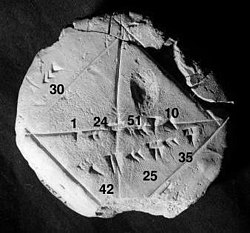Babylonian Mathematics

The Babylonian Mathematics was developed by the various inhabitants of Mesopotamia ( Mesopotamia in present-day Iraq developed). It probably began in the days of the early Sumerians (around 4000 BC) and continued to develop until the Persians conquered Babylon in 539 BC. Chr. Continued. In contrast to the mathematics of the Egyptians , of which only a few sources exist because of the sensitive papyri, there is a collection of around 400 clay tablets of Babylonian mathematics , which have been excavated since around 1850. Our knowledge is based on this. The notes were carved into the soft clay with cuneiform and burned or dried in the sun. The majority of the tablets found date from the period between 1800 and 1600 BC. And cover topics such as fractions, algebra , quadratic and cubic equations, the Pythagorean theorem and Pythagorean triples ( Plimpton 322 ). On the table YBC 7289 there is an approximation for with an accuracy of six decimal places.
Babylonian number system
A fully developed place value system was used to represent numbers . Numbers were represented in the sexagesimal system , a place value system based on 60. Remnants of this number system can still be found today in our representation of angles (1 ° = 60 ', 1' = 60 '') and times. Since 60 = 2 · 2 · 3 · 5 has the numbers 1, 2, 3, 4, 5, 6, 10, 12, 15, 20 and 30 as a divisor, significantly more numbers can be written in finite representation than in the decimal system, which made numerical calculations much easier. Numbers were written digit by digit, like today, from left to right, with the digits of greater significance on the left.
Digit from 1 to 59:
The Babylonians did not know a number for zero . It was not viewed as a number, but represented as the absence of a number and with a space.
Formulas for area and volume calculation were available. For the number π , 3 was often used as an approximation; a table gives the better approximation 3 + 1/8.
The Pythagorean theorem was known, but only in terms of its application, not in the sense of a mathematical proof.
Even Babylonian astronomers were able to measure the diameter of the earth . It is believed that the measurement attributed to Eratosthenes today was not carried out by him at all, but that he was aware of an older Babylonian measurement that had been carried out between Mount Ararat and a capital in Mesopotamia, transferred from Eratosthenes to Egypt and claimed as a separate achievement has been.
Sumerian Mathematics (3000-2300 BC)
The oldest evidence of written mathematics comes from the Sumerians, who developed one of the earliest known cultures in Mesopotamia. A powerful system of measurement originates from this time. Since 2600 BC Multiplication tables, geometrical and arithmetic tasks are proven.
Older Babylonian Mathematics (2000–1600 BC)
Most of the clay tablets for mathematics found come from this era. The content of the tables consists of lists and tables, in other cases they deal with problems and worked out solutions.
arithmetic
Prepared tables were used to support the arithmetic. Two tablets that were found in Senkerah on the Euphrates in 1854 and that date back to 2000 BC Lists with all square numbers up to 59 and cubes up to 32. The square numbers, especially the quarter-square table, made it possible to calculate products with an addition and two subtractions, as well as to find two squares in a square-number table with the formulas.
(Quarter square method). Instead of z. For example, to calculate 3 · 6 directly, one calculates 3 + 6 = 9 and 6 - 3 = 3 (larger minus smaller!) And looks up the quarter squares of 9 and 3 in the table ( ). Result: 20.25 and 2.25. These two numbers are subtracted to give the product 20.25 - 2.25 = 18.
The division was not carried out with a direct algorithm, but with the formula
traced back to multiplication. Extensive tables with the reciprocal values were available for this purpose.
The reciprocal values of 7, 11, 13 and the like no longer have a finite representation in the sexagesimal system. Therefore z. B. used for 1/13 approximations:
algebra
Quadratic equations were solved using the formula, which all students can still learn today. Since no negative numbers were available, about
with b and c , which are not necessarily whole numbers, but positive as
specified. The (clearly positive) root was taken from the square table.
The solution of cubic equations was also known. For this purpose, n 3 + n 2 were tabulated. To solve
the equation was multiplied by a 2 and divided by b 3 with the result
The substitution y = ax / b gives
This can be resolved for y by looking up n 3 + n 2 in the table to find the best value for the right hand side. (Example: ; . The table returns and )
The calculation was done without algebraic notation, which indicates a remarkably deep understanding of the underlying mathematics. There are no indications for knowing the general cubic equation.
As the relatively well-known clay tablet YBC 7289 proves, square roots could be calculated with high accuracy using the Heron method .
Summary: Complex calculations with real numbers were carried out using tables. A short excerpt from such a table is given for understanding:
n n^2 n^2/4 1/n n^2+n^3
1 1 0 1,000000 2 2 4 1 0,500000 12 3 9 2 0,333333 36 … 3,75 66,8 … 4 16 4 0,250000 80 5 25 6 0,200000 150 6 36 9 0,166667 252 7 49 12 0,142857 392 8 64 16 0,125000 576 9 81 20 0,111111 810 10 100 25 0,100000 1100 …
geometry
The general rules for area and volume calculation were known. The circumference U of a circle with diameter d was assumed to be U = 3 · d and the area A to be A = U · U / 12. The bad approximation uses both . The Pythagorean theorem was used but not proven; the idea of proving was first developed by the Greeks. There are tables with the Pythagorean triplets like (3, 4, 5).
Chaldean Mathematics (626-539 BC)
The Chaldean period is that of the New Babylonian Empire (626-539 BC), the second heyday of the city of Babylon. The city was the capital of the empire and a center of science. However, the sources for this time are less favorable.
Since the rediscovery of Babylonian culture, it has become apparent that the Greek astronomers, especially Hipparchus , had information from Chaldean sources.
Franz Xaver Kugler showed in his book Die Babylonische Mondrechnung that moon phases already appear in Babylonian ephemeris tables, which, according to Ptolemy (Almagest IV.2), were improved by Hipparchus and himself taking into account older observations of the "Chaldeans". According to Kugler, these values appear in a collection of tablets now known as "System B", which is sometimes attributed to the astronomer Kiddinu . Obviously, Ptolemy and Hipparchus only checked the older values through current observations.
We know that Hipparchus, and later Ptolemy, had essentially complete lists of eclipses spanning several centuries. These lists are likely derived from clay tablets containing all of the relevant observations routinely recorded by the Chaldeans. Preserved tablets are from 652 BC. Chr. To 130 n. Chr. Dated, but the records were likely until the reign of King Nabonassar back from Babylon. Ptolemy's record begins on the first day of the Egyptian calendar of the first years of the reign of Nabonassar, i.e. on February 26, 747 BC. Chr.
The raw data was probably difficult to use, so excerpts were made. So one has z. B. Found boards with all eclipse events. Specifically, there is a table with all the eclipses of a Saros cycle . This made it possible to identify periodic repetitions of astronomical events. The following periods were found in system B ( Almagest IV.2):
- 223 synodic months = 239 anomalous months = 242 draconian months . This period is now called the Saros cycle and is used to predict eclipses.
- 251 synodic months = 269 anomalous months
- 5458 synodic months = 5923 draconian months
- 1 synodic month = 29; 31: 50: 08: 20 days (sexagesimal; decimal value: 29.53059413 ... days = 29 days 12 hours 44 min 3⅓ s)
The Babylonians expressed all periods in synodic months, as a lunisolar calendar was likely used. Different relationships of phenomena in the course of the year led to several values of the length of the year .
Several measured values for their orbits around the sun were also known for other planets. The values that Ptolemy ascribes to the astronomer Hipparchus in Almagest IX.3 already existed as predictions on older Babylonian tablets.
It is unclear when, to what extent and how parts of this knowledge became accessible to the Greeks. This was only possible because Babylonian scholars wrote works in the Greek language, because the Greeks did not learn any foreign languages and could not read cuneiform texts.
















